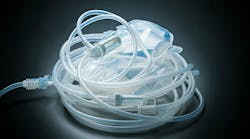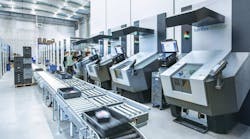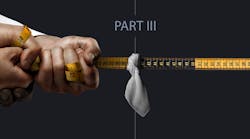Winston Churchill reportedly said, “Democracy is the worst form of government, except for all the others.” So it is with capacitive humidity sensors. These sensors can perform amazingly well in some environments and terribly in others. There are many benefits and disadvantages to capacitive humidity sensors. Let’s look at some of them.
Fundamental vs. Secondary
Fundamental measurement devices depend on some intrinsic physical phenomenon to provide consistent, high performance measurement. In the world of humidity, chilled mirror hygrometers achieve this by controlling the temperature of a surface so that condensation remains in an equilibrium state on that surface. The temperature of the surface is measured, yielding a very accurate dewpoint measurement expressed in the International System of Units. By contrast, the capacitive humidity sensor is a secondary device. It relies on a dielectric material and how that material changes as a function of relative humidity. The dielectric material can be “fooled” into responding to substances other than water vapor, and it can drift over time due for a variety of reasons. So, why doesn’t everyone use a chilled mirror hygrometer? For starters, they can be two to three orders of magnitude more expensive than capacitive sensor based devices. They are heavy, complex, sensitive to flow rates, and need regular maintenance. The tradeoff between the two technologies: users of capacitive sensors sacrifice some performance for price, simplicity and ease of use.
Simplicity
Capacitive humidity sensors are simple. They consist of two plates sandwiching a dielectric material. Each plate has a “leg” for an electrical connection. The sensor is attached to an appropriate device for measuring capacitance. What could be easier? Well, it’s not really that easy. First of all, the plates have to be permeable to water vapor or the response time of the sensor would be far too slow. The plates are typically very thin layers of metal, often sputtered onto a base material. This requires sophisticated equipment and process knowledge. Some sensors are manufactured in clean rooms to obtain uniformity and consistency. This is not simple. Furthermore, the actual change in the sensor’s capacitance is quite small over the humidity range of 10 - 90%. Electronic circuits for measuring the sensor have to be designed carefully to measure this small change, and stray capacitance has to be eliminated in all wiring that connects the sensor to the electronics. These are not issues for users, but knowledge of these details might help users understand the differences in price and performance between instruments that appear to be the same.
Contamination
All humidity sensors must be in contact with the gas that they measure. Anything in the gas that “disagrees” with the sensor can alter the sensor’s performance. For example, small oil droplets in aerosol form can coat the sensor, forming a barrier that limits water vapor permeability. Dust can accumulate on the sensor with a similar effect. The most difficult contaminants are chemicals that interfere with or change the nature of the dielectric material.
These contaminants can be sneaky. When the sensor is exposed to them, they create measurement error. In some cases, when the sensor is removed from service for calibration, the contaminants may outgas and the measurement error disappears. Other contaminants may cause permanent damage to the dielectric. Sensors from different manufacturers may react differently because of differences in dielectric material or sensor design. All sensors have strengths and weaknesses when it comes to contamination, but sorting them out is nearly impossible without direct testing. This is the nature of capacitive humidity sensors. Unfortunately, every humidity measurement technology is also subject to degradation due to contamination.
Environmental Conditions
Capacitive humidity sensors are big winners when it comes to environmental conditions. They can withstand high and low temperatures. They can measure in saturated conditions and “dry as a bone” conditions. They outperform most technologies when it comes to extremes. Clever tricks can extend the sensor performance. For example, when measuring warm and moist conditions, condensation may form on the sensor and corrupt the measurement. This can be avoided by heating the sensor prior to exposing it to warm and moist conditions. Caution: Don’t use a torch to heat the sensor. Look for a humidity instrument that has this function in the design.
In conclusion, capacitive humidity sensors are not a universal solution for humidity measurement, but they’re pretty darn close. They are suitable for the vast majority of humidity measurement applications.





